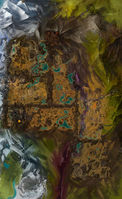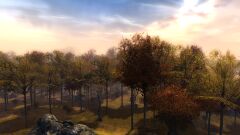Ascalon
Ascalon
86 119 142 37 62
- Levels
- 1–25, 30–70, 80
- Type
- Region
- Within
- Tyria
- Connects to
- Kryta
Shiverpeak Mountains
| Image(s) |
|
Click to enlarge. |
Ascalon is the domain of Iron Legion charr. It is a temperate, moderately lush region that has been fought for by the charr and humans for centuries. Countless conflicts and major magical disasters have left their mark on the landscape and people inhabiting the land, namely, the charr invasion and Searing of Ascalon, the Foefire and the creation of Dragonbrand. To this day, the charr High Legions continue to struggle with the aftereffects of those events such as the Ascalonian ghosts, the rogue Flame Legion and Branded minions of the Elder Dragon Kralkatorrik.
History[edit]
The land known as Ascalon was originally claimed by the charr sometime before 100 BE when they conquered the indigenous grawl,[1] though if they had any name for the region is not known. However, they were driven north into the region referred to as the Blood Legion Homelands by humans pushing north and east. The ongoing human-charr conflict lasted for around 1,100 years, culminating at the end of the Third Guild War when the human kingdom of Ascalon was all but destroyed by the charr shamans using magical cauldrons granted to them by titans under orders of Abaddon, the fallen human god. The event became known as the Searing, and it left all of Ascalon scorched and barren in 1070 AE.
Following the Searing, renewed charr war efforts placed the remaining human population of Ascalon in ever-increasing jeopardy. While King Adelbern led a resistance against the charr, his son Rurik led many of the survivors to Kryta in search of refuge. Though Rurik himself was slain by the Stone Summit dwarves, the remaining refugees established the Ascalon Settlement and eventually the Rurikton district of Divinity's Reach. Thirty years after the Searing, Adelbern and his guard made their last stand during a siege on Ascalon City. Using the powers of his ancient sword Magdaer, the king summoned the Foefire which engulfed most of Ascalon, killing the charr in immediate vicinity but effectively killing all humans in Ascalon and transforming their spirits into vengeful ghosts bent on fighting the charr eternally.
In the two centuries since then, the once barren lands have slowly recovered and life has gradually returned, though scars of the Searing and ruins of the human kingdom still mark the landscape. On the site of Rin, the ancient capital of the human kingdom of Ascalon, the Iron Legion have raised their Black Citadel. Their war against living humans continued until recent years against the lone fortress of Ebonhawke which is now the last human settlement of Ascalonian heritage. The ghosts of Foefire continue to defend their ruined realm as defiantly as centuries ago.
The year 1320 AE was by all standards the most remarkable year in history of Ascalon; the Elder Dragon Kralkatorrik awoke in north, in the Blood Legion homelands. It flew south to the Crystal Desert, passing above Ascalon and creating a swath of corruption in its wake which became known as the Dragonbrand. Countless charr and wildlife were immediately transformed into minions of the dragon known as the branded. This severely crippled the war effort of charr against the last human stronghold, urging both participants to seek truce in 1324 which evolved into ongoing peace negotiations as of 1325. The credit for achieving the truce often goes to Queen Jennah's efforts to end the war, and the retrieval of the Claw of the Khan-Ur by Dougal Keane of Ebonhawke and Ember Doomforge of the Ash Legion. Separatist humans and Renegade charr still fight to keep the ancient war alive, preferring to fight their own people rather than accept peace with their sworn enemies.
Geography and climate[edit]
Due to its lush and arid climate zones, Ascalon is populated by wide variety of flora and fauna. Besides being largely populated by the charr, the region also serves as home for ogres of Blazeridge Mountains and the tribal grawl, among other sentient and semi-sentient creatures. Aside from the human Separatists, the only notable human settlement is the Stronghold of Ebonhawke hugging the southern Blazeridge Mountains. Several enemy factions occupy vast territories in Ascalon: Ascalonian ghosts can be encountered along the Northern Wall and in the Ascalon City Ruins, and the Flame Legion dominates the area north of the wall, where the volcano Hrangmer and its Citadel of Flame are located. Kralkatorriks minions, the branded, swarm through the Dragonbrand and beyond.
The geography of Ascalon was completely transformed from its lush and idyllic environment to a barren wasteland of ash following the Searing. The magic ritual also left large crystal formations in the landscape, some of which continue to exist. Following two and half centuries of recovery from the ecological catastrophe, the land is slowly returning to life. Its progress is threatened by not only the Elder Dragon's influence but also by the Flame Legion's destructive magics.
Locations[edit]
- Cities
- Explorable zones
- Core Game
- Plains of Ashford (1–15)
- Diessa Plateau (15–25)
- Fields of Ruin (30–40)
- Blazeridge Steppes (40–50)
- Iron Marches (50–60)
- Fireheart Rise (60–70)
- Dungeons
- Ascalonian Catacombs (30, 35)
- Citadel of Flame (70, 75)
Ascalon Explorer achievement[edit]
This achievement consists of discovering 177 areas (out of a possible 178) within Ascalon. Some commonly missed areas are as follows:
- Plains of Ashford – Langmar Estate (added Feb 2013); Abbey Ruins
- Diessa Plateau – The Wurm's Gullet
- Fields of Ruin – Last Stand Shelter
- Blazeridge Steppes – Agrak Kraal
- Fireheart Rise – Rebel's Seclusion; Vexa's Lab
Interactive map[edit]
Gallery[edit]
The Ascalon City Ruins.
The Northern Great Wall.
One of the crystals that caused The Searing.
The Dragonbrand Kralkatorrik.
The gates of the Stronghold of Ebonhawke.
Trivia[edit]
| The Guild Wars Wiki has an article on Ascalon. |
- Ascalon was the first region of the world explored during gameplay in the original Guild Wars.
- Ascalon was the Hellenized name for the ancient city of Ashkelon in the Levant. Ascalon was the last city of the Philistines to fall to the Babylonians in 604 BCE, after which the city was burned to the ground. Later, Ascalon became part of the Crusader Kingdom of Jerusalem. In 1191, it was conquered and demolished by the Muslim leader Saladin.
- Ascalon was also the name of the sword from the common legend of St. George and the Dragon.
- Internally at ArenaNet, this region was known as "Regrown" while zones in the region were given names such as "Regrown_Brand" for Blazeridge Steppes.[2]
See also[edit]
References[edit]
- ^ Planet of the Grawl
- ^ Comments by Linsey Murdock, Reddit.com



















